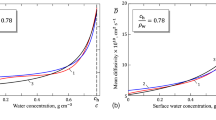Abstract
Understanding the human cutaneous barrier function is one of the main goals in the study of skin physiology. The plastic occlusion stress test (POST) is a well-known, dynamic approach for studying the barrier, evoking an over-stimulation of the cutaneous water assessed by the trans-epidermal water loss (TEWL) measurement. Rigorous data analysis is imperative, and the compartmental model proposed is particularly suitable for this purpose. It provides a dynamic quantitative description of water mass, but also helps to disclose the relative influence of other factors, such as the time of occlusion. Ten healthy volunteers were submitted to POST studies with different occlusion periods (1 h, 6 h, 12 h and 24 h), allowing the full application of the model to the measured desorption curves. After fitting, the influence of the occlusion time over the evaporation half-lives (t1/2evap) is apparent (t1/2evap ranging from 2.46 min for 1 h of occlusion to 8.53 min for 24 h), increasing with time. Considering the wide applicability of the POST to the study of in vivo cutaneous physiology and pathophysiology, these results demonstrate that the time of occlusion must be considered as a key factor in POST measurements.
Similar content being viewed by others
References
Berardesca, E., Fideli, D., Borroni, G., Rabbiosi, G., andMaibach, H. (1990a): ‘In vivo hydration and water-retention capacity of stratum corneum in clinically uninvolved skin in atopic and psoriatic patients’,Acta Derm. Venereol.,70, pp. 400–404
Berardesca, E., andMaibach, H. (1990b): ‘Monitoring the waterholding capacity in visually non-irritated skin by plastic occlusion stress test (POST)’,Clin. Exp. Dermatol.,15, pp. 107–110
Berardesca, E., Vignoli, GP., Fideli, D., andMaibach, H. (1992): ‘Effect of occlusive dressing on the stratum corneum water holding capacity’,Am J Med Sci.,304, pp. 25–28
Berardesca, E., Herbst, R., andMaibach, H. (1993): ‘Plastic occlusion stress test as a model to investigate the effects of skin delipidization on the stratum corneum water holding capacityin vivo’,Dermatology,187, pp. 91–94
D'Argenio, D., andSchumitzky, A. (1997): ‘ADAPT II User's Guide’. Pharmacokinetic/Pharmacodynamic System Analysis Software, Biomedical Simulations Resource, Los Angeles
Fluhr, J., Lazzerini, S., Distante, F., Gloor, M., andBerardesca, E. (1999): ‘Effects of prolonged occlusion on stratum corneum barrier function and water holding capacity’,Skin Pharmacol Appl Skin Physiol.,12, pp. 193–198
Ganong, W. (1999): ‘The general and cellular basis of medical physiology’, in Barnes, D. and Ransom, J., (Eds): Review of medical physiology (Appleton & Lange, 1999), pp. 1–45.
Food and Drug Administration (1999): ‘Guidance for Industry: Population pharmacokinetics’, US Department of Health & Human Services
Pinnacoda, J., Tupker, R. A., Agner, T., andSerup, J. (1990): ‘Guidelines for transepidermal water loss (TEWL) measurement. A report from the standardization group of the Europ. Soc. Contact Dermatitis’,Cont. Derm.,22, pp. 164–178
Pinto, P. C., Pereira, L. M., Minhós, R., andRodrigues, L. M. (2002): ‘Testing the discriminative capacity of compartmental modelling for the analysis of thein vivo epidermal water content changes following a topical intervention’,IFSCC Mag.,5, pp. 87–92
Pinto, P. C., (2003): ‘Mathematical modelling of the epidermal barrier function’. MSc thesis, Universidade Lisboa, p. 101
Rodrigues, L., Pinto, P., Galego, N., Amores Da Silva, P. andMarcelo Pereira, L. (1999): ‘Transepidermal water loss kinetic modelling approach for the parametrization of skin water dynamics’,Skin Res Tech.,5 pp. 72–82
Rodrigues, L., Pinto, P., andMarcelo Pereira, L. (2003): ‘Quantitative description of human skin water dynamics by a disposition-decomposition analysis (DDA) of trans-epidermal water loss and epidermal capacitance’,Skin Res Tech.,9, pp. 24–30
Rodrigues, L. M., Magro, J. M., Pinto, P. C., Mouzinho, Ma., Almeida, MaA. (2004): ‘Non-invasive assessment of wound healing pathophysiology by transcutaneous indicators’,Ann Burns Fire Disast.,27, pp. 131–136
Rogiers, V. (2001): EEMCO Group, EEMCO ‘Guidance for the assessment of transepidermal water loss in cosmetic sciences’,Skin Pharmacol Appl Skin Physiol 14, pp. 117–128
Van Neste, D. (1990): ‘In vivo evaluation of unbound water accumulation in stratum corneum’,Dermatologica,181, pp. 197–201
Wilson, D., andMaibach, H. (1994): ‘A review of transepidermal water loss’, inElsner, P., Berardesca, E., andMaibach H. (Eds): ‘Bioengineering of the skin: Water and the Stratum corneum’ (CRC Press, 1994) pp. 83–110
Author information
Authors and Affiliations
Corresponding author
Rights and permissions
About this article
Cite this article
Pinto, P.C., Rodrigues, L.M. Influence of the time of occlusion on the quantitative parameters obtained by modelling trans-epidermal water loss curves to describe the human cutaneous barrier functionin vivo . Med. Biol. Eng. Comput. 43, 771–775 (2005). https://doi.org/10.1007/BF02430956
Received:
Accepted:
Issue Date:
DOI: https://doi.org/10.1007/BF02430956




